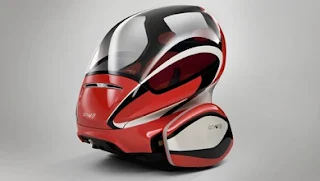Back in the 1939-40 World's Fair in New York, General Motors' Futurama attraction stole the show with its depictions of life 20 years into the future. After the misery of the Great Depression, GM's vision of personal car ownership and a vast interstate freeway system promised a new era of freedom.
Now, 70 years later, in many congested cities around the world, cars have become more like prisons--trapping motorists in traffic jams and preventing them from doing what they want to do. What's more, they're blamed for destroying the environment.
So when this year's World Expo opens May 1 in Shanghai, a city of 19 million people intimately familiar with the problem of gridlock, GM and its Chinese partner will be offering a different concept of personal urban mobility: networked, driverless cars that don't pollute, don't crash and take up less space.
GM and Shanghai Automotive Industry Corp. (SAIC) unveiled the EN-V (Electric Networked-Vehicle) concept Wednesday in Shanghai. It's a fleshed-out version of a personal mobility concept GM unveiled a year ago, in conjunction with Segway, the maker of self-balancing electric vehicles that you ride standing up. With no sides or roof, the concept looked like some sort of electric rickshaw. Because of the timing, as GM was seeking a federal bailout, the concept was greeted with snickers and raised eyebrows.
But fully dressed with lightweight carbon fiber body panels, the EN-V is easier to appreciate. GM and SAIC unveiled three versions Wednesday in Shanghai: the light-hearted Xiao (Laugh), with its gumball blue paint and nautical-inspired design; the sleek and masculine Miao (Magic), which takes most of its design cues from the consumer electronics industry, and features innovative LED lighting; and the brightly colored Jiao (Pride), which takes its design influence from bullet trains and Chinese opera masks.
Just five feet long and weighing about 900 pounds, EN-V is a two-seater that runs on electricity. Don't worry about speeding tickets: EN-V's top speed is 25 miles per hour. But at least you'll be moving instead of sitting in traffic. EN-V's global positioning system (GPS), combined with vehicle-to-vehicle communications, allows it to automatically choose the fastest route, based on real-time traffic information. That could reduce congestion in cities like Shanghai (a target market for this kind of vehicle) where GM says the average traffic speed is 10 mph.
The autonomous technology could also cut down on the number of accidents. Using embedded sensors and cameras, EN-V can sense what's around it, enabling it to react quickly to obstacles or changes in driving conditions. For example, if a pedestrian steps out in front of the vehicle, EN-V will automatically slow down and can stop sooner than any motorist can in today's vehicles.
It is propelled by electric motors in each of its two wheels. About a third the size of a traditional vehicle, EN-V maneuvers easily because of its zero turning radius and can travel at least 25 miles on a single charge. EN-V's smaller size and greater maneuverability mean a parking lot can accommodate five times as many EN-Vs as typical automobiles.
For densely populated cities like Shanghai, GM believes it needs to come up with a new type of vehicle, or it'll quickly be out of business.
Maybe there are also some uses in small city like Singapore, say in the market for aunties, or in the Changi Airport travelling around terminal to terminal ( with the luggage or without ), or moving around at the Sentosa Resort World or Universal Studio park, or say mega shipyards for workers or supervisors to move around the yard instead of the use of bicycles........ who knows, if the price is right and demand is there, people will pay for it if the need.
http://www.youtube.com/watch?v=PVBZhuL5E2g

No comments:
Post a Comment